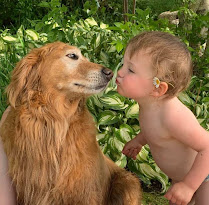by Beth Sullivan
 |
The littlest ones will always need a
guiding hand. |
Happy
New Year. A new year, a new decade, possibly a new way to think. Most of us try
to start a new year with resolutions, or at least good intentions to do
something different. It might be to exercise more, eat healthier, or lose
weight. It also could be to take a class, start a project, or learn a skill.
For others it is cleaning up, clearing out, purging papers, and reducing
clutter in our lives.
I
got thinking about a different path. Maybe it’s because ‘2020’ is also linked
with good vision. We are able to look forward clearly but also be in the
present clearly, consciously.
Our
vision for the future is entirely entwined with our children, the children of
the world. Think of what we can teach them. What can we show them, both
beautiful and inspiring, and not so beautiful but hopefully inspiring in a
different way? All parents know you cannot force a toddler or a teenager to
comply with our every wish, but what we can do is gently and patiently open
their eyes to their potential and guide them on a 2020 path of clear sight to
improve our world and make a positive difference. It’s just one year,
concentrating not on ourselves, but having a greater vision and understanding
that as one person, we can truly make a difference. Maybe it will become a new
habit.
 |
Some contacts don't need masks.
Encourage them. |
That is what I wrote
for the first blog of 2020.
Who could
have known what we would go through and witness with our “2020 vision”?
But I read those words several times and
realized there was a lot of truth to them, but maybe not exactly what we
imagined.
“A new way to think”: That’s
for sure.
We all had to change how we
thought about almost everything.
So many
things we took for granted, now became focal points. People we may have taken
for granted, were now recognized as essential.
Hugging and touching, basic human contacts became actions we had to
pre-think and even avoid.
We were all
finally getting on the right track to avoid plastics, disposables and bringing
our own bags to the grocery store. Unfortunately, I am afraid the pandemic put
some of the ecological thinking on the back burner for a while. Much of the large
scale, international, and certainly national efforts to clean up the
environment and reduce emissions became secondary to the pandemic affecting
lives all around the world.
 |
Maybe our new exposure to such places
will increase our desire to preserve
and protect them |
But think about the
rest of it: there really were ways we grew, and many more opportunities to
observe and appreciate what we have. One of the most obvious side- impacts of
2020, had to do with people being more aware of the natural world. It was truly
unfortunate that many people had to give up jobs, or work from home, and kids were
out of school, but it created opportunities for many of us to turn to Nature
for recreation, exercise, education, companionship and respite. As an outcome,
just possibly, children may have come to greater curiosity, understanding and
love for Nature and with that will come a caring for the environment, habitats
and ecosystems in the future.
So, my hope for 2021 is that we have learned from 2020
insights. We have learned the importance
of people and services that are truly essential. We need to trust science in
matters of health, and environment. We
will never take for granted a hug, a handshake or even a smile. We have come to know our outdoor havens and
how good nature is for the soul. Let’s
please resolve to keep other important things in our vision for 2021 to remain
safe and grateful for the good in the world.
Wishing a Happy, Healthy New Year to all. Beth
 |
There are many mysteries to be unraveled this winter
|
 |
The ultimate sign of hope that the winter
ahead will end. |
 |
Maybe when the bloodroot blooms this spring,
things will be a lot better. |
 |
| Natural intricacies are not changed by human concerns. |





















